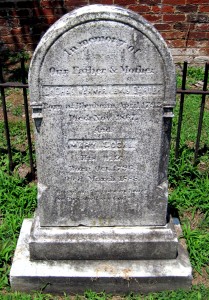
Carter-Gilmer House, Charlottesville, north elevation, drawn by Pierre Crosby, 1982 for UVa School of Architecture project under the direction of K. Edward Lay. Courtesy of Library of Congress Prints and Photographs Division, Washington, D.C., accessed 30 August 2011.
Charles Warner Lewis Carter, born in 1792 in Virginia, was the second oldest signer of the fee bill. He bought four lots and built a federal-style townhouse as his family residence in the 1820s at the corner of East Jefferson Street and North Eighth Street in Charlottesville. The building has been modified over the years but is still in use.1 He practiced medicine at the brick office in his side yard.2 He also advertised in the Virginia Advocate, a Charlottesville newspaper, that he would perform operations on teeth that were normally done by dentists.3 He practiced medicine for many years in partnership with Dr. Hardin Massey.4
Charles Ellis, a University of Virginia student, made numerous references in his diary about going to Dr. Carter’s house in 1835.5 Sara Pryor, the niece of one of the fee bill signers, moved to Charlottesville around 1839 and wrote a book about her life. She included Dr. Carter as one of the “society” members of Charlottesville in the 1840s.6 He was known as “… a gentleman of kind, generous and social qualities and highly respected by the entire community. He was a member of Widows Son [Masonic] Lodge, also of the Episcopal Church.”7 He was elected to the vestry of Christ Church in 1842.8

Dr. Chas. Warner Lewis Carter, Born at Blenheim, April 17, 1792, Died Nov. 1867 and Mary Cocke his wife Born Oct. 1796, Died March 1888. Maplewood Cemetery, Charlottesville.
Carter was one of the signers of the petition to release John Mosby from jail, as well as the doctor called to look after George Turpin after Mosby shot him.9 He was also the Albemarle County representative in the Virginia House of Delegates in 1851 and a member of the Board of Overseers of the Poor for Albemarle for 28 years.10 Dr. Carter had business interests and served as a director of the Albemarle Insurance Company which “… sold life, fire, and marine insurance, [and] also accepted deposits from those who wished to safeguard their funds.”11
In his late sixties at the onset of the Civil War, Dr. Carter continued to practice medicine. He was employed as a contract physician during the war, and for several months he was in charge of Midway Hospital, one of several in Charlottesville that supported the war effort. A diary written by Confederate nurse Ada Bacot indicates Dr. Carter continued to open his house to others. She writes that he insisted she and another nurse spend the night at his home after a fire broke out near her residence. She states, “… we then followed dear old Dr. Carter on to his Hospitable house, where we were received by his sweet wife in the most affectionate manner.”12 Dr. Carter was married to Mary Cocke who outlived him by more than twenty years, was the father of a son who died in the Mexican-American War and a daughter, and owned ten slaves and real estate worth $4,000 according to the U.S. Census of 1850. He died in 1867.13
- James Alexander, Early Charlottesville: Recollections of James Alexander, 1828-1874, reprinted from the Jeffersonian Republican by the Albemarle County Historical Society, edited by Mary Rawlings, 1963 notes and revisions by Velora Carver Thomson ([Charlottesville, Va.: The Michie Co., Printers], 1963), 45; Ellen Qualls, “The Carter-Gilmer House,”The Bulletin of the Albemarle County Historical Society 8, no.2 (April/May 1988): 4. [↩]
- Department of Community Development, Charlottesville, Virginia, Historic Landmark Study, Prepared for Landmarks Commission ([Charlottesville, Va.: Michie Co.], 1976), 195. [↩]
- Charles Ellis, “The Student Diary of Charles Ellis, Jr., March 10-June 25, 1835,” edited by Ronald B. Head, The Magazine of Albemarle County History 34-36 (1977-1978): 95. [↩]
- Edgar Woods, Albemarle County in Virginia (Bridgewater, Va.: C.J. Carrier Co., [1956?]), 266. [↩]
- Ellis, 95. [↩]
- Sara Pryor, My Day: Reminiscences of a Long Life (New York: Macmillan, 1909), 54. [↩]
- Alexander, 46. [↩]
- Jennie Thornley Grayson, “Old Christ Church, Charlottesville, Virginia, 1826-1895,”Papers of the Albemarle County Historical Society 8 (1947-1948): 53; K. Edward Lay, The Architecture of Jefferson Country, Charlottesville and Albemarle County, Virginia (Charlottesville: University Press of Virginia, 2000), 53. [↩]
- William M.E. Rachal, “Petitions Concerning the Pardon of John S. Mosby in 1853,” Papers of the Albemarle County Historical Society 9 (1948-1949): 17; John S. Patton, “John S. Mosby and the University,” Alumni Bulletin of the University of Virginia, 3d ser., 10, no. 2 (April 1917): 153. [↩]
- Woods, 385; “Mary Catherine Murphy, “Abstracts of Obituaries in Charlottesville Newspapers 1860-1869,” The Magazine of Albemarle County Historical Society 23 (1964-1965): 49. [↩]
- Newton Bond Jones, Charlottesville and Albemarle County, Virginia 1819-1860, A Dissertation Presented to the Graduate Faculty of the University of Virginia in Candidacy for the Degree of Doctor of Philosophy (1950), 194-195. [↩]
- Ada W. Bacot, A Confederate Nurse: the Diary of Ada W. Bacot, 1860-1863 (Columbia: University of South Carolina Press, 1994), 132. [↩]
- Woods, 163, 405; Slave Schedule, 1850, Federal Census, Albemarle, Virginia (Charlottesville), accessed 23 March 2011; U.S. Census: Albemarle, Virginia, 1850, accessed 13 July 2011; William Bolling, “Diary of Col. William Bolling of Bolling Hall,” The Virginia Magazine of History and Biography 45 (1 January 1937): 29; George Selden Wallace, The Carters of Blenheim, A Geneology of Edward and Sarah Champe Carter of “Blenheim” Albemarle County, Virginia (Richmond, Va.: Garrett & Massie, Inc., 1955), 69-70. [↩]

